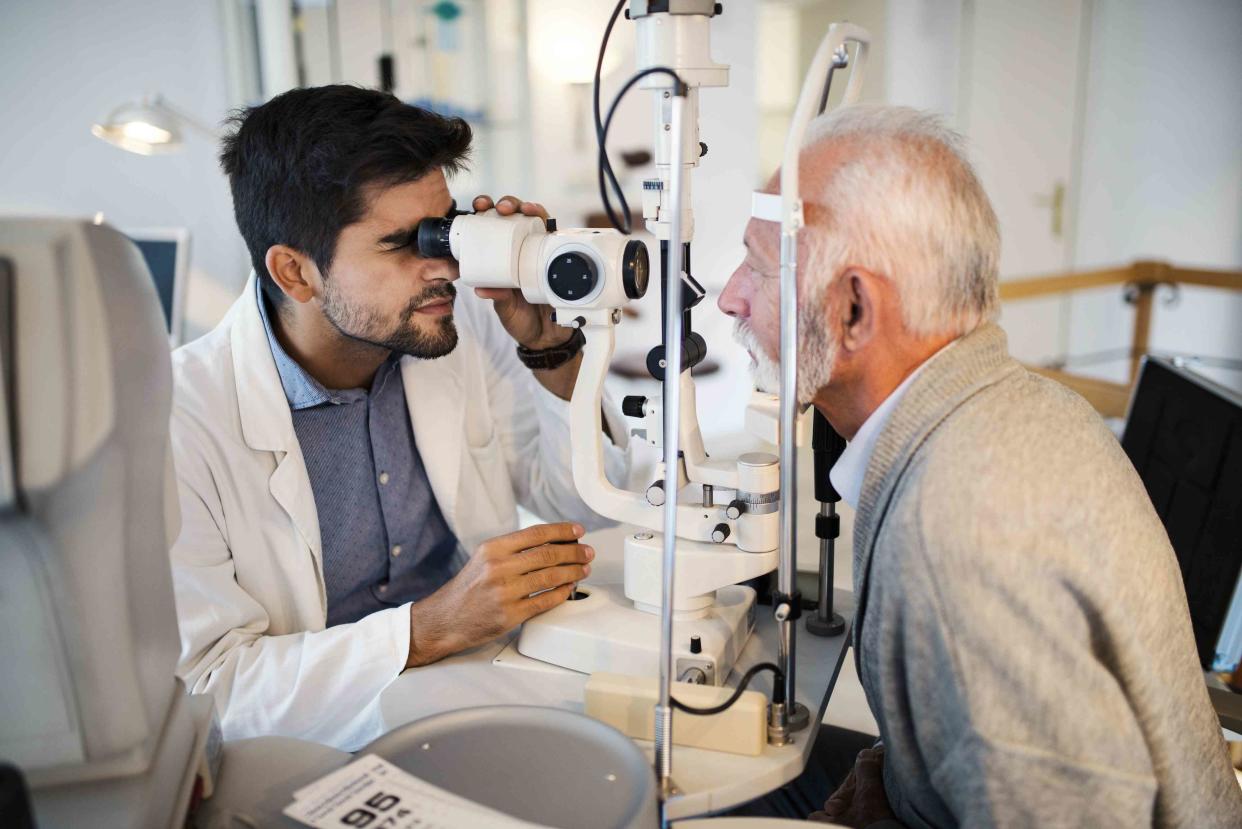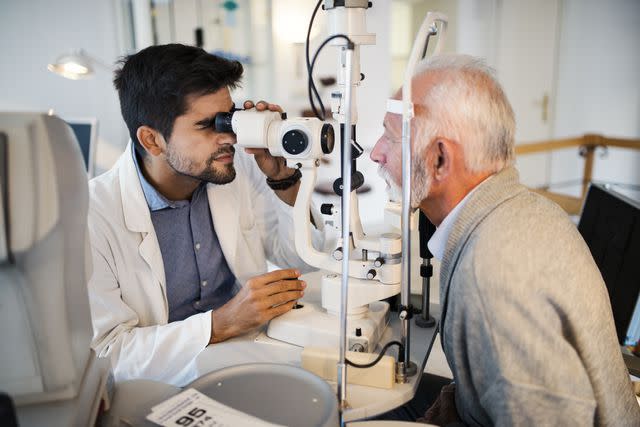Facts About Age-Related Macular Degeneration

Martinns / Getty Images
Medically reviewed by Andrew Greenberg, MD
You may have heard that age-related macular degeneration (AMD) is a leading cause of vision loss in people over the age of 50, but what you may not realize is that most people with AMD don't lose their vision completely.
Age-related macular degeneration is a complex disease that causes the macula of your retina (the part of the eye responsible for clear, central vision and the ability to see details) to deteriorate. Your genetic makeup, environmental factors, and lifestyle choices can all affect your risk and how this condition progresses.
This article will uncover some facts and myths about this disorder and how it differs from other age-related vision changes.

Martinns / Getty Images
Read Next:Macular Degeneration
AMD Fact #1: Vision Loss Will Occur
Although AMD is the leading cause of severe vision loss or impairment in older adults, this condition doesn't always lead to complete blindness. A part of your retina called the macula deteriorates with macular degeneration.
The macula is located at the back of your eye and uses photoreceptor cells to detect light and send information about what you are seeing to your brain. In particular, the macula processes visual information for your central vision, while other components of the retina process information from your peripheral vision. This means that macular degeneration may cause central vision loss, but you may still have some vision left around the sides of your eyes.
It is important to understand that you can be legally blind without having complete vision loss. You are considered legally blind if your vision is 20/200 or less. This means you can clearly see at 20 feet what someone with perfect vision could see at 200 feet.
AMD is most common in people over age 65, but other changes can happen to your vision with age. It might be hard to tell the difference between regular age-related vision changes and macular degeneration, but some distinguishing factors exist, such as:
Macular degeneration primarily affects your central vision.
Age-related vision changes usually affect how clearly you see images up close.
Aging affects how well your eyes can adjust to light.
AMD Fact #2: Age at Diagnosis Is 65
Although symptoms may appear earlier, age-related macular degeneration usually affects people age 55 or older. Most AMD diagnoses are made after the age of 65, and it's rare for symptoms to appear before age 50. However, it's uncommon for macular degeneration to develop without symptoms in the early stages.
Some forms of macular degeneration can appear at an earlier age. Juvenile macular degeneration, or Stargardt disease, usually occurs between ages 6 and 12. The condition is generally unavoidable, developing even before birth due to genetic mutations, but it's also rare. Only 1 in 10,000 children are affected, but getting an accurate diagnosis can take up to age 20.
AMD Fact #3: Dry and Wet AMD Differ
Not all forms of AMD are the same. The impact on vision and disease progression differentiates dry AMD from wet AMD.
Dry AMD is the most common type. It makes up about 90% of all age-related macular degeneration cases. It is caused by the gradual thinning and deterioration of the macula, causing discoloration and the collection of tiny clumps of waste called drusen.
Dry AMD doesn't always progress past this early stage to a level of noticeable vision loss. Nearly everyone over 50 has at least one of these drusen.
Wet AMD often develops as a progression of dry age-related macular degeneration. The evolution from dry to wet macular degeneration happens when new blood vessels grow underneath the retina. These blood vessels are weak and can leak blood and other fluids into the layers of the retina, causing the formation of scar tissue and damage to retinal cells.
About 10% of cases of macular degeneration progress to the wet variety, resulting in rapid and severe vision loss.
AMD Fact #4: Diet Has an Impact
Nutrition impacts the development of many chronic conditions, and AMD is no exception. Antioxidants like vitamins A, C, and E and carotenoids like lutein and zeaxanthin can help reduce cellular aging. Diets lacking in these nutrients are associated with an increased risk of developing AMD and rapid vision loss progressions of vision loss.
A Mediterranean diet is believed to reduce the risk of developing AMD since this eating plan is naturally rich in antioxidants. The Mediterranean diet mainly includes fruits, vegetables, legumes (beans, peas, and lentils), grains, and nuts, while limiting meat and dairy products.
Conversely, eating foods with a high glycemic index that can cause rapid shifts in blood sugar levels due to their high levels of carbohydrates can increase your risk of developing AMD. It also can make existing macular degeneration progress faster.
Learn More:Is the Green Mediterranean Diet Healthier?
AMD Fact #5: Smoking Has an Impact
Smoking is one of the most high-risk behaviors contributing to macular degeneration. Various studies have ranked smoking as one of the most significant avoidable risk factors for AMD. People who smoke are up to 4 times more likely to develop the condition than those who don't smoke.
The amount you smoke and when you quit can play a role, too. Smoking has a dose-response effect on AMD, meaning the more you smoke, the greater your risk for developing AMD. While the risk decreases when you quit smoking, people with a history of tobacco use have higher rates of AMD than people who have never smoked.
AMD Fact #6: Damage Is Called Geographic Atrophy
Geographic atrophy is the name for the extensive damage caused by the deterioration of the macula that happens with dry age-related macular degeneration. There are several stages of dry AMD, and geographic atrophy is the advanced form of the disease. With it, physical and structural changes to the retina occur. Rapid vision changes and loss are common in late-stage AMD and geographic atrophy.
Summary
Age-related macular degeneration is most often diagnosed in people age 65 and older but can develop earlier with minimal symptoms. There are many myths and misconceptions about AMD, but certain factors, like smoking and poor diet, are strongly linked to an increased risk. If AMD runs in your family, or you notice changes in your central vision, talk to your healthcare provider about screening for AMD.

